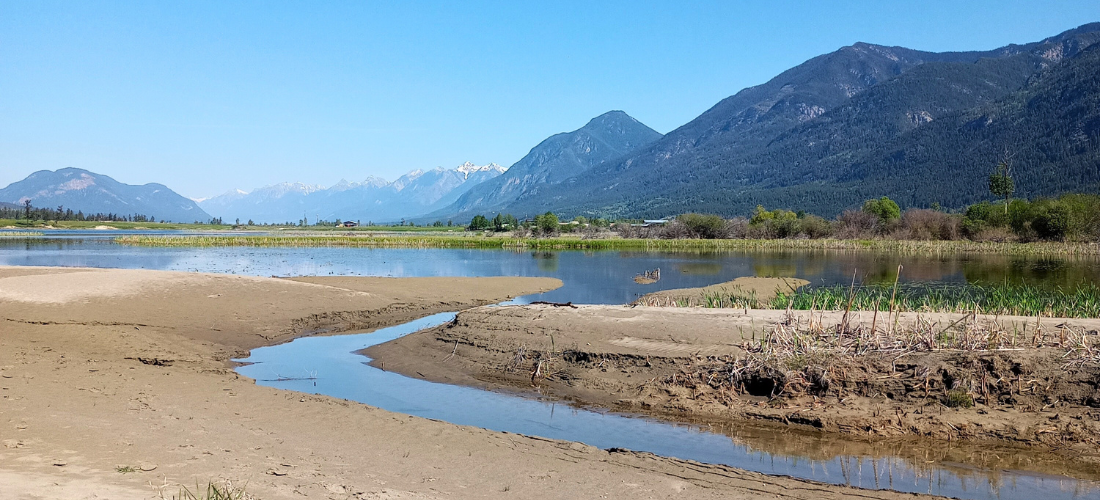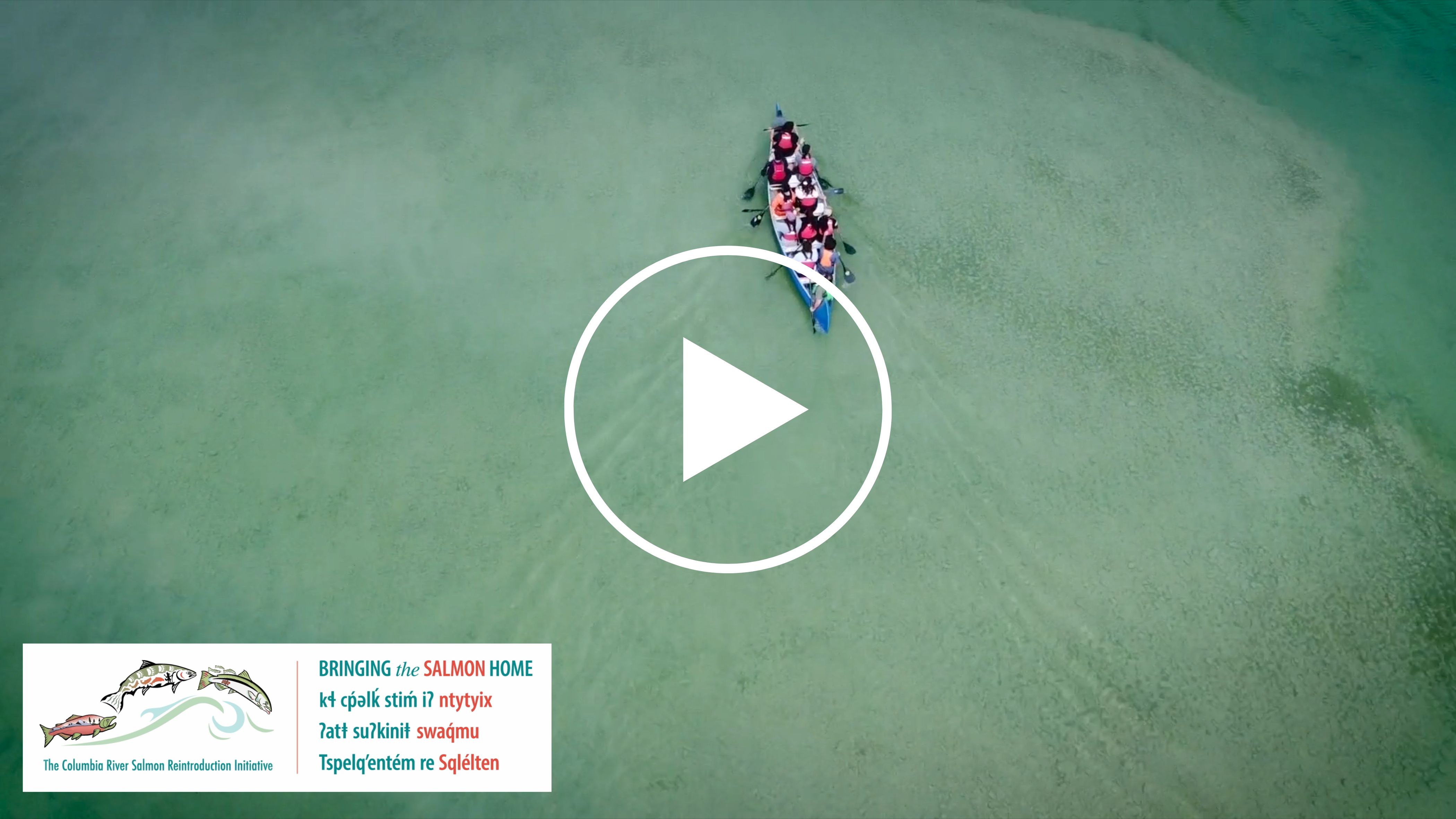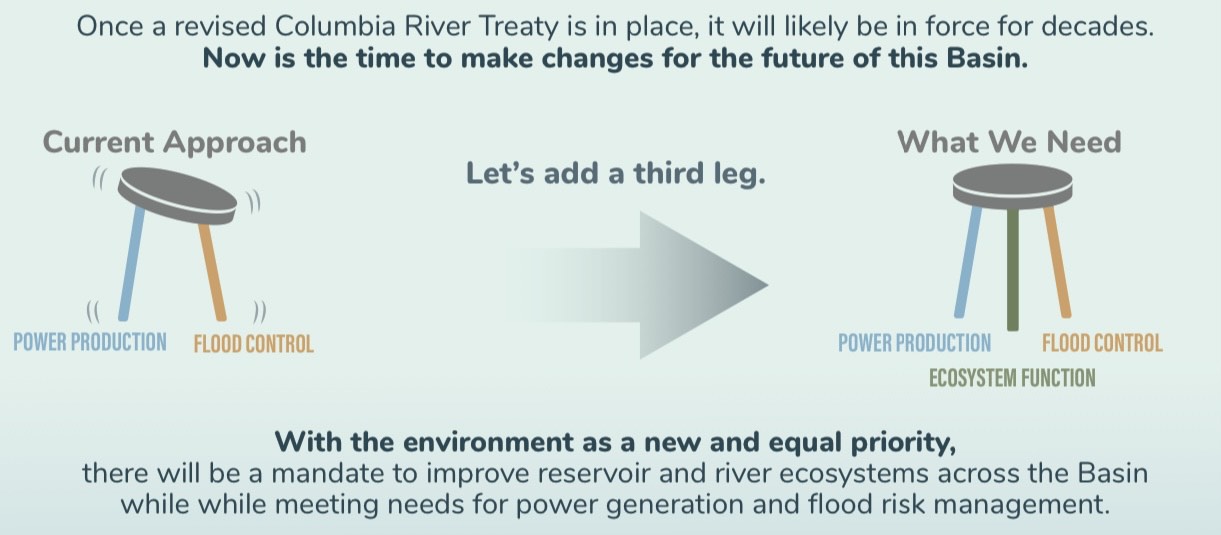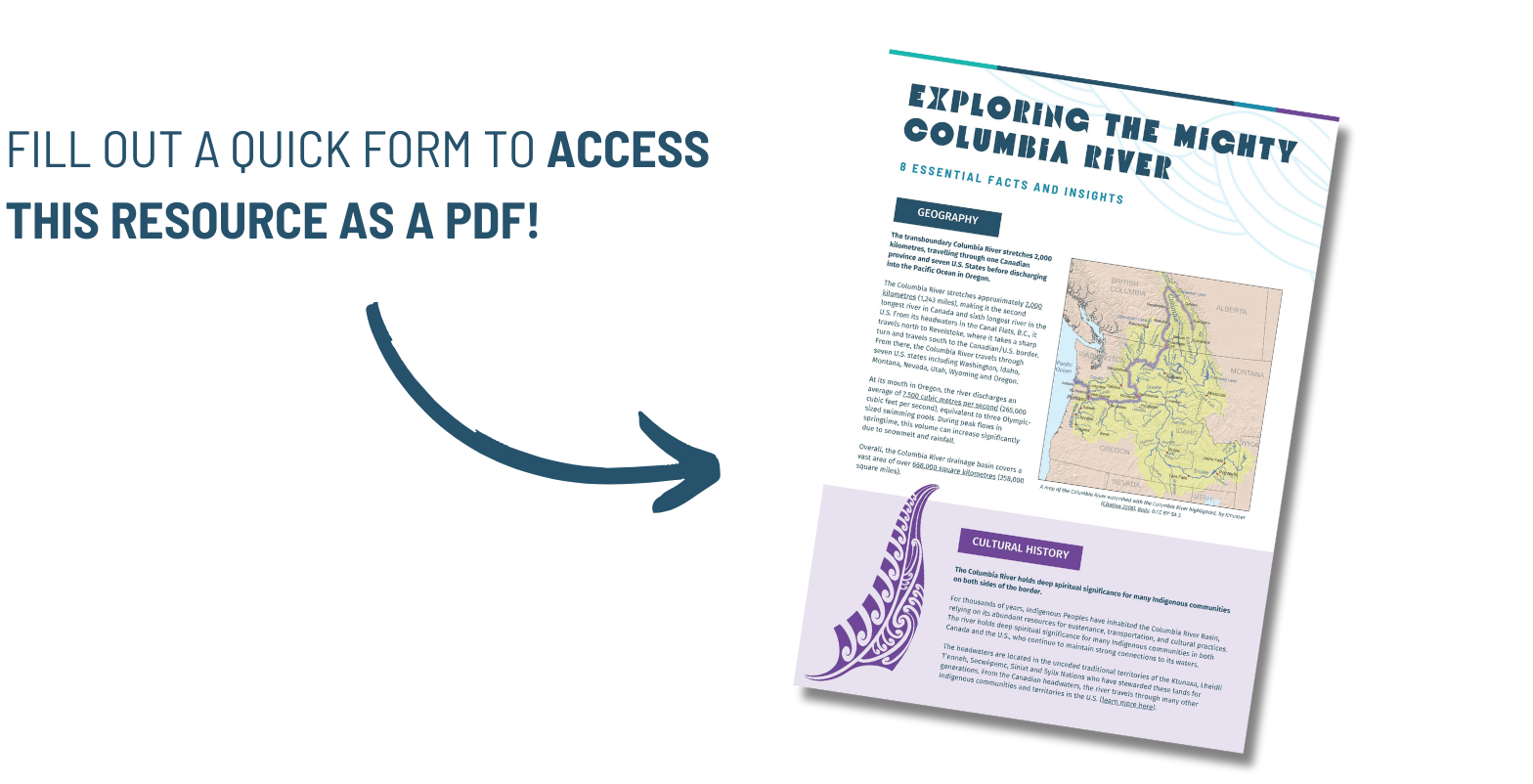Exploring the Mighty Columbia River
8 Facts and Insights
Considered one of North America’s most important water towers, the transboundary Columbia River Basin supplies fresh water to millions of people and has played a vital role in shaping the landscape, culture, and history of the Pacific Northwest.
Here are 8 important facts about this iconic waterway:
Geography
The transboundary Columbia River stretches 2,000 kilometres, travelling through one Canadian province and seven U.S. States before discharging into the Pacific Ocean in Oregon.
The Columbia River stretches approximately 2,000 kilometres (1,243 miles), making it the second longest river in Canada and sixth longest river in the U.S. From its headwaters in the Canal Flats, B.C., it travels north to Revelstoke, where it takes a sharp turn and travels south to the Canadian/U.S. border. From there, the Columbia River travels through seven U.S. states including Washington, Idaho, Montana, Nevada, Utah, Wyoming and Oregon.
At its mouth in Oregon, the river discharges an average of 7,500 cubic metres per second (265,000 cubic feet per second), equivalent to three Olympic-sized swimming pools. During peak flows in springtime, this volume can increase significantly due to snowmelt and rainfall.
Overall, the Columbia River drainage basin covers a vast area of over 668,000 square kilometres (258,000 square miles).
Note: This is a map of the Columbia River watershed with the Columbia River highlighted, by Kmusser (Citation 2008), https://bit.ly/3CQQXKG. 0.CC BY-SA 3.
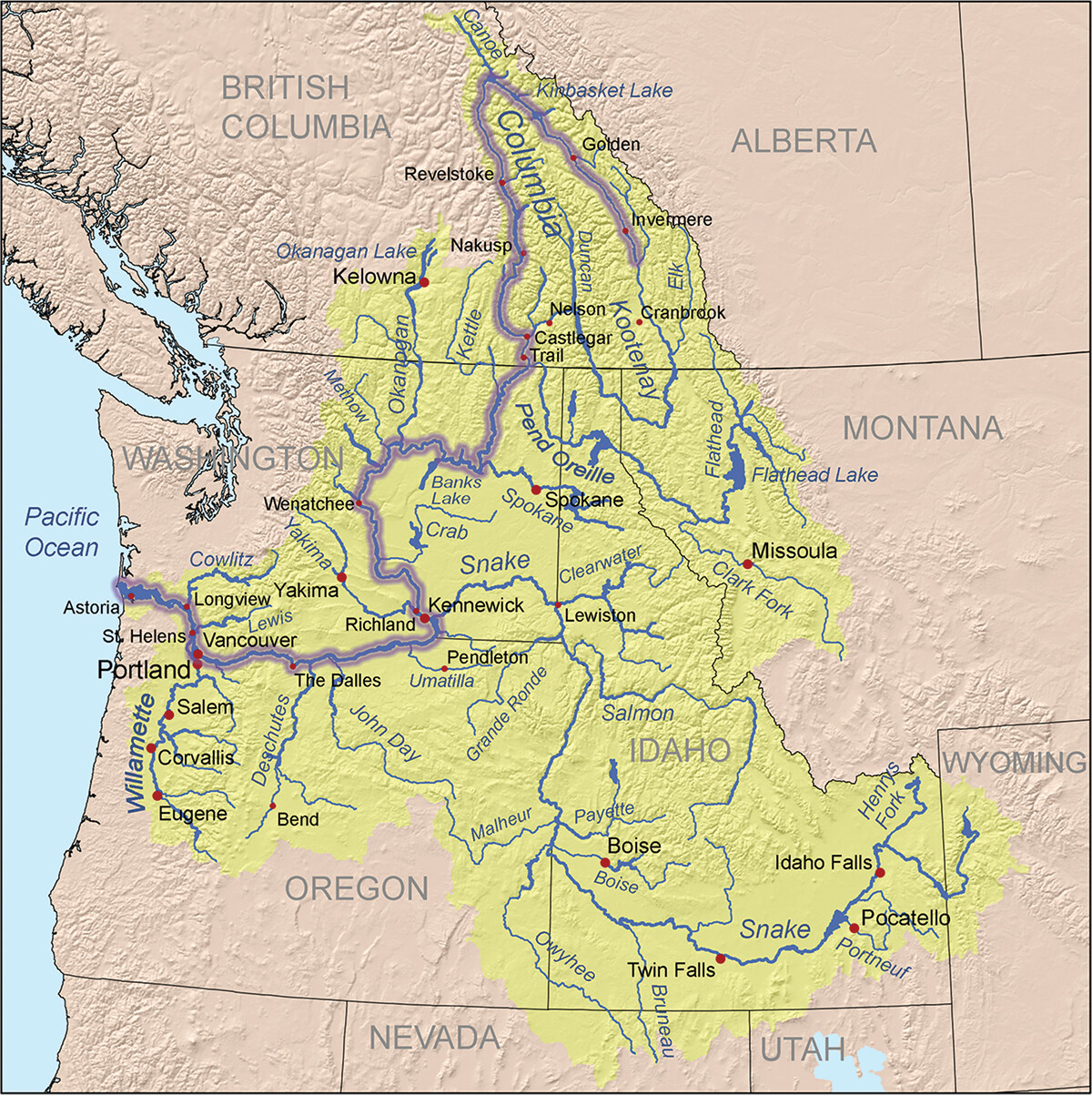
Cultural History
The Columbia River is vitally significant for many Indigenous communities on both sides of the border.
For thousands of years, Indigenous Peoples have inhabited the Columbia River Basin, relying on its abundant resources for sustenance, transportation, and cultural practices. The river holds deep spiritual, cultural, social and economic significance for Indigenous communities in both Canada and the U.S., who continue to maintain strong connections to its waters.
The headwaters are located in the unceded traditional territories of the Ktunaxa, Secwépemc, Syilx, Lheidli T’enneh, and Sinixt Nations who have stewarded these lands for generations. From the Canadian headwaters, the river travels through many other Indigenous communities and territories in the U.S.
Columbia Wetlands
Located in the Canadian headwater, the only un-dammed stretch of the river, lies the internationally recognized and remarkable biodiverse Columbia Wetlands.
In the Canadian headwaters, the Columbia River feeds into the Columbia wetlands, the largest intact wetlands in North America. Stretching over 180-kilometres (110-miles) and across 26,000 hectares, the Columbia Wetlands support an incredible amount of biodiversity and provide a cornucopia of benefits to surrounding communities.
Flood control, groundwater recharge, irrigation needs, water purification, and carbon storage — these wetlands aid it all. As part of the Pacific Flyway, one of North America’s four major migratory routes, the waters of the Columbia Wetlands provide a safe haven for over 160 species of migratory birds including at-risk Tundra Swans.
Although the Columbia Wetlands are Ramsar-designated and internationally recognized, approximately 40% of this pristine floodplain remains unprotected. Vulnerable to climate change impacts, ongoing research shows that the Columbia Wetlands are drying. Learn more about the efforts to restore the wetlands.
Hydroelectric Power
The Columbia River is one of the most developed river systems in the world for hydroelectricity, and is guided by the 1964 Columbia River Treaty between Canada and the U.S.
On both sides of the border, the Columbia River is one of the most hydroelectrically developed river systems in the world for hydroelectricity with a whopping 470 dams on the main river and tributaries. Most dams were built between the 1940s and 1980s, guided by the 19614 Columbia River Treaty between Canada and the U.S. Notable dams include the Grand Coulee and Chief Joseph dams in Washington, and Keenleyside Dam in British Columbia.
While these dams harness the power of the Columbia River and its tributaries to generate clean, renewable energy for communities on both sides of the border, they also have obstructed migratory routes for salmon, cutting Indigenous communities off from not only an important food source, but a crucial part of Indigenous culture.
Ecosystem Connectivity
The Columbia River supports the migration of many species including fish and birds, but the development of dams has impeded ecosystem connectivity.
The Columbia River serves as a vital corridor for wildlife migration and provides critical refuges for species such as salmon, trout, and migratory birds. It once supported one of the largest salmon runs in the world, with millions of fish returning annually to spawn in its tributaries.
However, habitat degradation, overfishing, and the construction of dams have severely impacted salmon populations, leading to conservation efforts to restore their habitats and migratory routes. These efforts include the development of fish ladders to help spawning fish bypass dams. But, in the U.S., not all dams are equipped with fish ladders, and in Canada, no dams have these structures. This has resulted in blocking salmon from returning to the Canadian portion of the upper Columbia River for more than 80 years.
The Bringing the Salmon Home: The Columbia River Salmon Reintroduction Initiative is an Indigenous-led collaboration of the Syilx Okanagan Nation, Ktunaxa Nation, Secwépemc Nation working to return salmon stocks for Indigenous food, social and ceremonial needs, and to benefit the region’s residents and ecosystem as a whole. Watch their recent film to learn more.
Transboundary Governance
The Columbia River is a U.S.-Canada transboundary river. Decisions on storing and releasing water through dams are currently guided by the 1964 Columbia River Treaty, an international agreement between the U.S. and Canada that is under renegotiation.
The transboundary nature of the Columbia River underscores the importance of cross-border cooperation and collaboration in sustainably managing water. Decisions on storing and releasing water from the Columbia River through dams are guided by the Columbia River Treaty (CRT), an international agreement between the United States and Canada ratified in 1964. The CRT currently coordinates flood control and optimizes hydroelectricity generation in both countries.
As climate change impacts like drought intensify, surface water is expected to become less reliable, impacting river, tributary and reservoir water levels. For example, Arrow Lakes Reservoir near Castlegar, B.C. experienced extremely low water levels in 2023, resulting in fish deaths and hampering tourism and recreation, all while having to meet CRT obligations to direct water southward.
Negotiations between the two countries to modernize the CRT and integrate respective and mutual water management objectives began in 2018. Ecosystem function has been an important focus in recent discussions in addition to the two main pillars of the original treaty, flood control and power generation.
At the beginning of July 2024, Canada and the US reached an Agreement-in-Principle to modernize the treaty. Learn more about this latest development.
Economic and Recreational Importance
The Columbia River support diverse economic activities including agriculture, shipping, manufacturing, tourism and recreation.
As a vital economic artery for the Pacific Northwest, the Columbia River supports economic activities such as agriculture, shipping, manufacturing, and tourism. Its navigable waters facilitate the transportation of goods and commodities, contributing to regional economic growth and prosperity. The Columbia River offers abundant recreational opportunities, including boating, fishing, hiking, and wildlife viewing. Visitors flock to the river’s scenic gorge, waterfalls, and expansive reservoirs, making it a popular destination for outdoor enthusiasts and tourists year-round.
Environmental Challenges
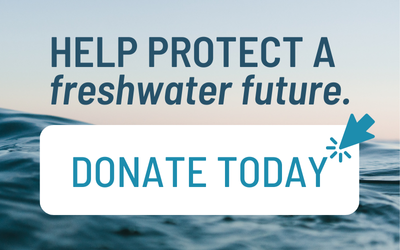 Habitat loss, water pollution, invasive species and climate change impacts all threaten the Columbia River.
Habitat loss, water pollution, invasive species and climate change impacts all threaten the Columbia River.
The Columbia River faces numerous environmental challenges, including habitat loss, water pollution, invasive species, and the impacts of climate change. Conservation efforts, collaborative management approaches, and restoration projects are essential for protecting the river’s ecological integrity and ensuring its sustainability for future generations.
Of particular concern, climate change is affecting water availability for human and biological populations, ecosystem health, and community resilience. Data-informed water management practices are needed to adapt to shifting hydrological conditions and ensure a water secure future.
SIGN UP for Living Lakes Canada’s newsletter to stay in the flow of water news and get involved in the protection of lakes, rivers, wetlands and watersheds.
Learn more about our water science and stewardship
The Columbia Basin Water Hub is an open access water database available for decision makers, researchers, students, professionals and the public. Visit the database.
The Columbia Basin Water Monitoring Framework is a coordinated monitoring network that helps track the effects of climate change and other impacts on water supply for communities and ecosystems, and aims to inform strategies for adaptive watershed management. Learn more.
The Columbia Basin Groundwater Monitoring Program aims to increase knowledge about groundwater resources through collecting and sharing groundwater level data from dozens of Volunteer Observation Wells. Learn more.

